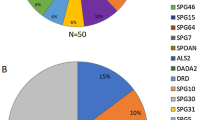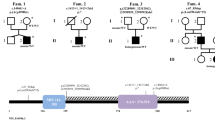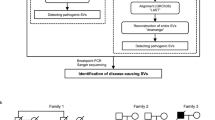Abstract
The SPAST gene has a major role in hereditary spastic paraplegias (HSPs). This is the first report mapping characteristics of the SPAST gene in a large cohort of Czech HSP patients. All 17 coding exons of the SPAST gene were Sanger sequenced in 327 patients from 263 independent families with suspected uncomplicated HSP. The selected 126 independent patients, without mutation in the SPAST gene after Sanger sequencing, were subsequently tested by Multiplex Ligation-dependent Probe Amplification (MLPA) assay for large deletions or copy number variations affecting the SPAST gene. Among the 263 independent patients, 35 different, small mutations in 44 patients were found. Twenty-one mutations are novel with the majority of frameshift mutations. Seven mutations were found in more than one family. The age at onset ranged between preschool childhood and the fifth decade with inter- and intra-familiar differences. SPAST small mutations were detected in 16.7% (44/263) of independent tested patients. Mutations in the SPAST gene were found more frequently in familial cases (with affected relatives). Mutation were found in 31.9% (29/91 familial tested) in the familial patient group, whereas in the sporadic patient group, mutations were found in only 4.7% of cases (5/106 sporadic cases). Among SPAST-positive patients, 65.9% (29/44) were familial but only 11.4% (5/44) were sporadic. MLPA testing revealed four large deletions in four independent patients, all in familial-positive cases. Mutations in the SPAST gene are 5.8 × more frequent in familial than in sporadic cases. Large deletions were found only in familial patients. Diagnostic testing of the SPAST gene is useful only in positive family history patients not in sporadic cases.
Similar content being viewed by others
Log in or create a free account to read this content
Gain free access to this article, as well as selected content from this journal and more on nature.com
or
References
Harding, A. E. Classification of the hereditary ataxias and paraplegias. Lancet 1, 1151–1155 (1983).
Fink, J. K. Hereditary spastic paraplegia. Curr. Neurol. Neurosci. Rep. 6, 65–76 (2006).
Hensiek, A., Kirker, S. & Reid, E. Diagnosis, investigation and management of hereditary spastic paraplegias in the era of next-generation sequencing. J. Neurol. 262, 1601–1612 (2015).
Hazan, J., Fonknechten, N., Mavel, D., Paternotte, C., Samson, D., Artiguenave, F. et al. Spastin, a new AAA protein, is altered in the most frequent form of autosomal dominant spastic paraplegia. Nat. Genet. 23, 296–303 (1999).
Kasher, P. R., De Vos, K. J., Wharton, S. B., Manser, C., Bennett, E. J., Bingley, M. et al. Direct evidence for axonal transport defects in a novel mouse model of mutant spastin-induced hereditary spastic paraplegia (HSP) and human HSP patients. J. Neurochem. 110, 34–44 (2009).
de Bot, S. T., van den Elzen, R. T., Mensenkamp, A. R., Schelhaas, H. J., Willemsen, M. A., Knoers, N. V. et al. Hereditary spastic paraplegia due to SPAST mutations in 151 Dutch patients: new clinical aspects and 27 novel mutations. J. Neurol. Neurosurg. Psychiatry 81, 1073–1078 (2010).
Erichsen, A. K., Inderhaug, E., Mattingsdal, M., Eiklid, K. & Tallaksen, C. M. Seven novel mutations and four exon deletions in a collection of Norwegian patients with SPG4 hereditary spastic paraplegia. Eur. J. Neurol. 14, 809–814 (2007).
Fonknechten, N., Mavel, D., Byrne, P., Davoine, C. S., Cruaud, C., Bonsch, D. et al. Spectrum of SPG4 mutations in autosomal dominant spastic paraplegia. Hum. Mol. Genet. 9, 637–644 (2000).
Sauter, S., Miterski, B., Klimpe, S., Bonsch, D., Schols, L., Visbeck, A. et al. Mutation analysis of the spastin gene (SPG4) in patients in Germany with autosomal dominant hereditary spastic paraplegia. Hum. Mutat. 20, 127–132 (2002).
Proukakis, C., Moore, D., Labrum, R., Wood, N. W. & Houlden, H. Detection of novel mutations and review of published data suggests that hereditary spastic paraplegia caused by spastin (SPAST) mutations is found more often in males. J. Neurol. Sci. 306, 62–65 (2011).
Solowska, J. M., Garbern, J. Y. & Baas, P. W. Evaluation of loss of function as an explanation for SPG4-based hereditary spastic paraplegia. Hum. Mol. Genet. 19, 2767–2779 (2010).
Svenson, I. K., Kloos, M. T., Gaskell, P. C., Nance, M. A., Garbern, J. Y., Hisanaga, S. et al. Intragenic modifiers of hereditary spastic paraplegia due to spastin gene mutations. Neurogenetics 5, 157–164 (2004).
Svenson, I. K., Ashley-Koch, A. E., Gaskell, P. C., Riney, T. J., Cumming, W. J., Kingston, H. M. et al. Identification and expression analysis of spastin gene mutations in hereditary spastic paraplegia. Am. J. Hum. Genet. 68, 1077–1085 (2001).
Orlacchio, A., Patrono, C., Borreca, A., Babalini, C., Bernardi, G. & Kawarai, T. Spastic paraplegia in Romania: high prevalence of SPG4 mutations. J. Neurol. Neurosurg. Psychiatry 79, 606–607 (2008).
Kim, T. H., Lee, J. H., Park, Y. E., Shin, J. H., Nam, T. S., Kim, H. S. et al. Mutation analysis of SPAST, ATL1, and REEP1 in Korean patients with hereditary spastic paraplegia. J. Clin. Neurol. 10, 257–261 (2014).
Ishiura, H., Takahashi, Y., Hayashi, T., Saito, K., Furuya, H., Watanabe, M. et al. Molecular epidemiology and clinical spectrum of hereditary spastic paraplegia in the Japanese population based on comprehensive mutational analyses. J. Hum. Genet. 59, 163–172 (2014).
Beetz, C., Nygren, A. O., Schickel, J., Auer-Grumbach, M., Burk, K., Heide, G. et al. High frequency of partial SPAST deletions in autosomal dominant hereditary spastic paraplegia. Neurology 67, 1926–1930 (2006).
Sulek, A., Elert, E., Rajkiewicz, M., Zdzienicka, E., Stepniak, I., Krysa, W. et al. Screening for the hereditary spastic paraplaegias SPG4 and SPG3A with the multiplex ligation-dependent probe amplification technique in a large population of affected individuals. Neurol. Sci. 34, 239–242 (2013).
Magariello, A., Tortorella, C., Patitucci, A., Tortelli, R., Liguori, M., Mazzei, R. et al. First mutation in the nuclear localization signal sequence of spastin protein identified in a patient with hereditary spastic paraplegia. Eur. J. Neurol. 20, e22–e23 (2013).
Meijer, I. A., Hand, C. K., Cossette, P., Figlewicz, D. A. & Rouleau, G. A. Spectrum of SPG4 mutations in a large collection of North American families with hereditary spastic paraplegia. Arch. Neurol. 59, 281–286 (2002).
Falco, M., Scuderi, C., Musumeci, S., Sturnio, M., Neri, M., Bigoni, S. et al. Two novel mutations in the spastin gene (SPG4) found by DHPLC mutation analysis. Neuromuscul. Disord. 14, 750–753 (2004).
Park, S. Y., Ki, C. S., Kim, H. J., Kim, J. W., Sung, D. H., Kim, B. J. et al. Mutation analysis of SPG4 and SPG3A genes and its implication in molecular diagnosis of Korean patients with hereditary spastic paraplegia. Arch. Neurol. 62, 1118–1121 (2005).
Acknowledgements
We thank all the patients and their families for their participation in this study. Ethical standards of experiments comply with the current laws of the country of origin. This study was supported by Ministry of Health of the Czech Republic, grant numbers 15-33041A and DRO 00064203.
Author information
Authors and Affiliations
Corresponding author
Ethics declarations
Competing interests
The authors declare no conflict of interest.
Rights and permissions
About this article
Cite this article
Mészárosová, A., Putzová, M., Čermáková, M. et al. SPAST mutation spectrum and familial occurrence among Czech patients with pure hereditary spastic paraplegia. J Hum Genet 61, 845–850 (2016). https://doi.org/10.1038/jhg.2016.73
Received:
Revised:
Accepted:
Published:
Issue date:
DOI: https://doi.org/10.1038/jhg.2016.73



